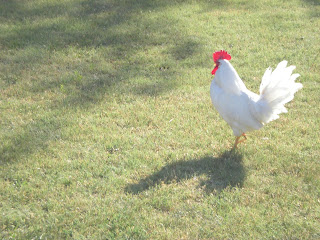Not to be unoriginal, but it was, indeed, the best of times -- and indeed the worst of times. My dedicated team of educators and support staff were working with me to create and nurture one of the largest and finest adult and community education programs in the nation. We worked hard, with a peace corps mentality and an urgency to make the American dream accessible to all who wanted it, to make a rich life of the mind approachable to all who had the energy to pursue it.
And then, with reasoning that defied logic, my organization and my position were gone, with the stroke of a pen. It was not a money thing. It was a political thing. At a time when our country and our community needed adult education more than ever, the decision was made to discontinue this organization that had stood so proudly, accomplished so much, and built such a strong sense of community.
Here are the remarks that I delivered at the retirement celebration which my wonderful staff held for me on May 29, 2009...
I stand, truly, on the shoulders of giants. If you were inclined to the lowest form of humor -- punnery -- you might say that I took a Plum* program and tried to make it Moore. I stepped into a program that was already great, built by the likes of Jane Cruz, Elaine Baush, and Ellen Carlos, scores of program specialists, hundreds of staff members, thousands of teachers and volunteers, and hundreds of thousands of learners.
And I have been in this great work for fully half of my life. And more than half of ACE's life, too.
And it is great work.
Adult education is not a profession for the faint of heart. It is a profession for the good of heart. In the United States, adult ed continues to be marginalized, underfunded and undervalued, poorly understood and poorly promoted.
There are always wolves scratching at our doors, threatening loss of funding loss of facilities space, loss of respect.
Partly this is because of our mission and the people whom we serve. We serve the displaced, the misplaced, the misguided, and the misunderstood; those who are down in the dumps or down on their luck; the dropouts, stopouts, locked up, messed up, dragged down, beaten down; and... the frivolous learners who only want to expand their minds, develop their skills, broaden their perspective, enrich their lives, improve their businesses, and build their communities.
But ACE** is about more than adult learners. We teach children of all ages, before and after school, on weekends and throughout the summer. We teach in businesses, community agencies, county offices. We teach school bus drivers and custodians and office workers and teachers. We promote lifelong learning in its purest sense. And we live what we promote.
And that's very important to us ACErs, to live what we promote, to be lifelong learners ourselves, to value ourselves and one another as we want our customers to value themselves.
And we are all teachers. Whether at the head of a classroom or the front of a registration line, a voice on the phone or a smiling face in the corridor, ACE staff and building coordinators and volunteers, as well as our instructors, teach and inform and guide our learners and customers.
This work has been a gift, given to us by our learners, our customers, our public. It's been a great run -- not without its bumps and wrinkles, frustrations, and challenges. But what an amazing group I have been running with. For so many years, we have laughed together, cried together, dreamed together, faced seemingly insurmountable challenges together -- and conquered those challenges.
But the time has come for me to take a different path. My traveling companion*** and I will be heading on a road trip, a sentimental journey of sorts, heading west top-down in my royal blue convertible. We'll be stopping for a few days in Cheyenne, Wyoming, where I will re-discover my inner cowgirl -- a few days in Boulder, Colorado, where I will rediscover my inner hippie -- mosey across the great Continental Divide -- and then spend some time in the San Francisco area visiting two of our sons, who are on their own grand adventures in the city by the bay. Then we'll head down the California coastal highway, meander along the southern route, and take our time getting home.
And you, dear ACErs, have much work left to do. This is a time of big changes, and change isn't easy. Despite the change in organization, the need for our services will not abate, the opportunities for coming up with creative solutions will not decrease, and the importance of your work will not be diminished. Remember that the work that you do is a gift -- a gift that you receive, and a gift that you give. Every time that you hear that hackneyed expression, "It is what it is", remember this: It is not (yet) what it could be. But you have the power to make it so.
And, those of you who cruised with me on the Good Ship Dandy earlier this month, please remember -- and tell the others -- you have got to keep the children together.
__________________________________
*Refers to Delegate Kenneth R. Plum, longtime Director of Adult & Community Education in Fairfax County. Ken built the program over a period of nearly 30 years, making an immeasurable contribution to the residents of Fairfax County, Virginia. It is in his honor that the Plum Center for Lifelong Learning was named.
**ACE stands for Adult & Community Education.
***My traveling companion is my husband of nearly 37 years, Garrett Moore. We have traveled many wonderful years and miles together.








